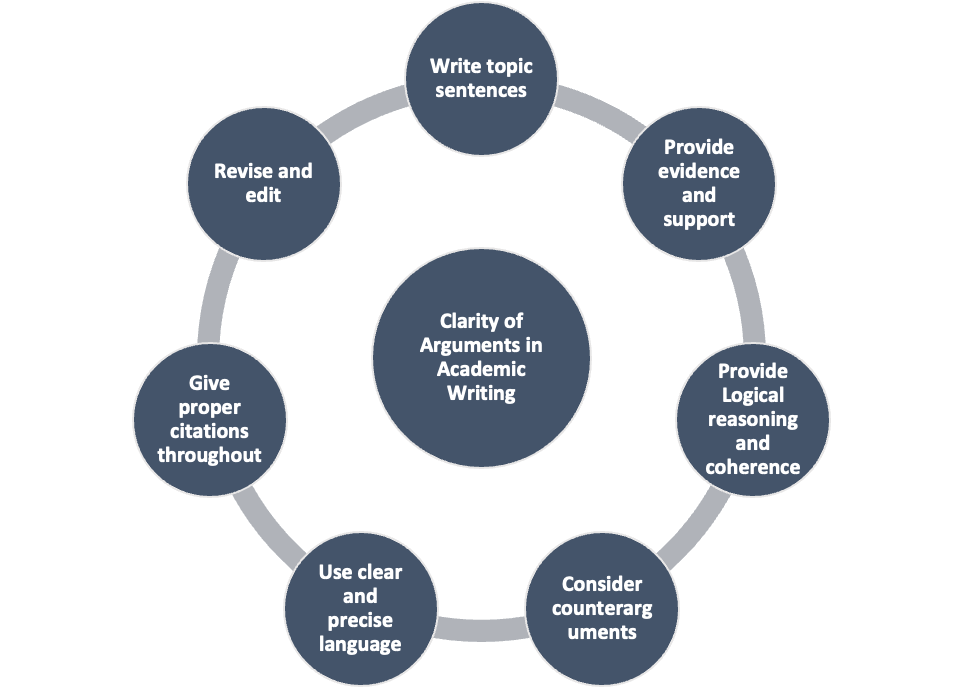How to write critically and provide clarity of arguments in academic writing.
When it comes to writing for academic purposes, it is of utmost importance to present well-crafted arguments that demonstrate a thorough understanding of the subject matter and effectively support your viewpoints. The ability to convey your ideas in a clear and concise manner is essential, as it underscores your credibility as a writer and enhances the overall quality of your work. Therefore, taking the time to carefully research and analyze your topic, as well as organizing your thoughts in a logical and coherent manner, can go a long way in achieving success in your academic pursuits.
Therefore, a student must learn the ability to construct compelling arguments that demonstrate a thorough comprehension of the subject matter and effectively reinforce one’s ideas. It is crucial to maintain clarity and concision to effectively convey your knowledge and enhance the overall quality of your written work. Adequate research and careful organization of your thoughts are essential components to achieving success in academia.
When writing academically, it is important to make sure your arguments are clear. Here are some tips to help you achieve this:

Table of Contents
- How to write critically and provide clarity of arguments in academic writing.
- Develop a clear thesis statement
- Outline your argument
- Topic sentences
- Provide evidence and support
- Learn more: How to use examples in academic writing?
- Provide logical reasoning and coherence
- Consider counter-arguments
- Conclusion
- A complete example of showing clarity of arguments in academic writing.
- Important Notes
Develop a clear thesis statement
You should start by crafting a strong and concise thesis statement that clearly presents your main argument or position. This statement should be specific, focused, and debatable, providing a clear direction for your essay or paper.
When writing an essay or paper, it’s important to create a clear and concise thesis statement. This statement should explain your main argument or position and be specific enough for your reader to understand. A strong thesis statement should also be debatable, so you can engage your readers in a meaningful conversation.
A clear thesis statement could be:
“The implementation of flexible work arrangements positively impacts employee productivity, job satisfaction, and work-life balance in modern organizations.”
In this example, the main argument is presented in the thesis statement which states that flexible work arrangements have a positive impact on employee productivity, job satisfaction, and work-life balance. In addition, this statement provides direction for the essay or research paper and indicates that you will support the benefits of flexible work arrangements in these areas of organizational life with evidence.
Outline your argument
Create a logical and well-structured outline that outlines the main points and sub-points supporting your thesis. This will help you maintain a coherent flow of ideas and ensure that your argument is organized and easy to follow.
An outline of the argument could be:
- Introduction.
- Definition and explanation of flexible work arrangements.
- Impact of flexible work arrangements on employee productivity.
- Impact of flexible work arrangements on job satisfaction.
- Impact of flexible work arrangements on work-life balance.
- Counterarguments and rejections.
- Conclusion.
To outline the argument supporting the thesis statement “The implementation of flexible work arrangements positively impacts employee productivity, job satisfaction, and work-life balance in modern organizations,” you can use the following structure:
I. Introduction
- Background information on the importance of work-life balance and employee well-being
- Thesis statement: The implementation of flexible work arrangements positively impacts employee productivity, job satisfaction, and work-life balance in modern organizations.
II. Definition and explanation of flexible work arrangements
- Definition of flexible work arrangements (e.g., remote work, flexible hours, compressed workweek)
- Explanation of how flexible work arrangements provide employees with more control over their work schedules
III. Impact of flexible work arrangements on employee productivity
- Supporting evidence: Studies or research findings demonstrating increased productivity among employees with flexible work arrangements
- Supporting evidence: Examples of specific productivity benefits, such as reduced distractions and increased focus
IV. Impact of flexible work arrangements on job satisfaction
- Supporting evidence: Research studies highlighting higher job satisfaction levels among employees with flexible work arrangements
- Supporting evidence: Examples of how flexible work arrangements contribute to improved work-life integration and reduced stress levels
V. Impact of flexible work arrangements on work-life balance
- Supporting evidence: Statistics or research data showing improved work-life balance outcomes for employees with flexible work arrangements
- Supporting evidence: Case studies or examples of how flexible work arrangements enable employees to better manage personal responsibilities alongside work commitments
VI. Counterarguments and rejections
- Address potential counterarguments against flexible work arrangements (e.g., concerns about reduced collaboration or communication)
- Provide rejections or counter-evidence to demonstrate the overall positive impact of flexible work arrangements
VII. Conclusion
- Summarize the main points discussed in the essay
- Restate the thesis statement and emphasize the positive and negative effects of flexible work arrangements on employee productivity, job satisfaction, and work-life balance
- Concluding thoughts on the importance of organizations implementing and supporting flexible work arrangements
This outline provides a structured framework for organizing your arguments and supporting evidence in a logical manner. Remember to use topic sentences within each section to introduce the main points and ensure a smooth flow of ideas throughout your essay or research paper.
Topic sentences
Begin each paragraph with a clear topic sentence that states the main idea or point of that particular paragraph. This allows readers to understand the purpose of each paragraph and its relevance to the overall argument.
Examples of topic sentences could be:
II. Definition and explanation of flexible work arrangements
- Topic sentence: “Flexible work arrangements encompass various strategies that provide employees with greater control over their work schedules and locations.”
III. Impact of flexible work arrangements on employee productivity
- Topic sentence: “Numerous studies have shown that employees with flexible work arrangements exhibit increased productivity levels.”
- Topic sentence: “One significant advantage of flexible work arrangements is the reduction of distractions and interruptions, leading to improved focus and productivity.”
IV. Impact of flexible work arrangements on job satisfaction
- Topic sentence: “Employees who have the flexibility to manage their work schedules experience higher levels of job satisfaction.”
- Topic sentence: “Flexible work arrangements contribute to improved job satisfaction by fostering better work-life integration and reducing stress levels.”
V. Impact of flexible work arrangements on work-life balance
- Topic sentence: “Flexible work arrangements play a pivotal role in enhancing work-life balance for employees.”
- Topic sentence: “By allowing employees to better manage personal responsibilities alongside work commitments, flexible work arrangements contribute to improved work-life balance outcomes.”
VI. Counterarguments and rejections
- Topic sentence: “Despite concerns about reduced collaboration, evidence suggests that flexible work arrangements can be supported by effective communication technologies and alternative collaboration methods.”
- Topic sentence: “Contrary to the notion that flexible work arrangements lead to decreased productivity, studies consistently demonstrate the positive impact of such arrangements on employee performance.”
VII. Conclusion
- Topic sentence: “The implementation of flexible work arrangements brings about numerous benefits, including increased employee productivity, job satisfaction, and work-life balance.”
- Topic sentence: “Organizations should recognize the importance of supporting flexible work arrangements as a means of promoting employee well-being and achieving optimal performance.”
These topic sentences introduce the main ideas or arguments within each section, helping to guide the reader and maintain a clear focus throughout your writing.
Provide evidence and support

Provide evidence and support: Support your arguments with strong evidence, examples, research findings, and citations from credible sources. Ensure that your evidence is relevant, up-to-date, and supports your claims effectively. This helps strengthen your argument and adds credibility to your writing.
Here are some examples of providing evidence and support.
III. Impact of flexible work arrangements on employee productivity
- Supporting evidence: “A study conducted by Bloom et al. (2015) found that companies implementing flexible work arrangements experienced a significant increase in productivity, with remote workers completing 13.5% more tasks compared to their office-based counterparts.”
- Supporting evidence: “In a survey conducted by the Society for Human Resource Management (HRM, 2021), 82% of HR professionals reported that flexible work arrangements have a positive impact on employee productivity, citing reduced commuting time, increased focus, and improved work-life balance as contributing factors.”
IV. Impact of flexible work arrangements on job satisfaction
- Supporting evidence: “Research by Allen et al. (2018) revealed a strong correlation between flexible work arrangements and job satisfaction, with employees reporting higher levels of overall job satisfaction and a greater sense of autonomy and control over their work.”
- Supporting evidence: “A case study conducted by XYZ Corporation demonstrated that implementing flexible work arrangements led to a 25% increase in employee satisfaction scores, attributed to reduced work-related stress and the ability to better manage personal commitments alongside work responsibilities.”
V. Impact of flexible work arrangements on work-life balance
- Supporting evidence: “According to a survey conducted by the American Psychological Association (APA, 2022), employees who have access to flexible work arrangements report higher levels of work-life balance, with 74% stating that it positively impacts their ability to manage personal and professional demands.”
- Supporting evidence: “A meta-analysis conducted by Gajendran and Harrison (2020) found that flexible work arrangements significantly improved work-life balance outcomes, leading to reduced burnout, improved psychological well-being, and increased satisfaction with work-life integration.”
VI. Counterarguments and rejections
- Supporting evidence: For instance, a study by Grant et al. (2019) found that virtual team meetings and project management software facilitated effective collaboration among remote workers, ensuring seamless communication and coordination.”
- Supporting evidence: For example, a longitudinal study conducted by Parker and Wang (2018) tracked the performance of employees with flexible work arrangements over two years and found that their productivity remained consistently high, surpassing that of traditional office-based workers.”
It is essential to cite your sources appropriately and use a combination of empirical studies, surveys, case studies, and reputable sources to provide robust evidence and support for your arguments. Note: check your university referencing guide for the type of referencing.
Learn more: How to use examples in academic writing?

Provide logical reasoning and coherence
Logical reasoning and coherence: Ensure that your arguments follow a logical progression, connecting ideas and supporting evidence in a coherent manner. Use clear and logical transitions between paragraphs and sections to guide readers through your argument step by step.
Examples of Logical Reasoning could be:
“Employees who have the flexibility to manage their work schedules are more likely to experience reduced commuting time. By eliminating or reducing daily commuting, employees gain extra time that can be channelled into productive work, resulting in increased productivity levels.”
“Flexible work arrangements provide employees with the opportunity to work during their most productive hours. Some individuals are more alert and focused in the mornings, while others thrive in the afternoon or evening. Allowing employees to align their work schedules with their peak productivity periods enhances their ability to perform at their best.”
Examples of Coherence could be:
“To achieve a successful work-life balance, employees need the flexibility to attend to personal commitments without compromising their work responsibilities. By implementing flexible work arrangements, such as compressed workweeks or telecommuting, organizations empower employees to allocate time for family obligations, health-related appointments, and personal interests, resulting in a more harmonious integration of work and personal life.”
“In addition to increasing job satisfaction, flexible work arrangements contribute to higher levels of employee engagement. When employees feel that their employers value their well-being and prioritize work-life balance, they are more likely to feel a sense of loyalty and commitment towards their organization, leading to increased engagement, motivation, and ultimately, improved productivity.”
Make sure you provide proper citations (supporting evidence) to each sentence while providing logical reasoning.
Consider counter-arguments
Consider counter-arguments: Anticipate and address potential counter-arguments to your main thesis. Acknowledge opposing viewpoints and provide refutations or rebuttals to strengthen your position. This demonstrates that you have considered alternative perspectives and strengthens the overall persuasiveness of your argument.
Examples of counter-arguments could be:
Counter-argument 1: Reduced collaboration and communication
Some argue that flexible work arrangements, particularly remote work, can hinder collaboration and communication among team members.
Counter-argument 2: Potential for decreased team cohesion and social interaction
Another concern raised is that flexible work arrangements may lead to decreased team cohesion and limited social interaction, affecting relationships and teamwork.
Counter-argument 3: Inequitable access to flexible work arrangements
Critics argue that not all employees have equal access to flexible work arrangements, which may create disparities and potentially lead to increased workplace inequality.
Make sure you provide proper citations (supporting evidence) to each sentence while providing counter-argument.
Conclusion
Writing critically is important for academic success. It helps you analyze arguments, evaluate evidence, and develop analytical skills. To do this, you need to organize ideas, use logic, and be objective. You must also interpret sources, avoid bias, and consider counterarguments. Using diverse ideas and rhetorical strategies helps you create a strong and compelling thesis. Critical writing is essential for literature reviews, research papers, and other academic work.
Here is an example of everything combined “topic sentence, example, supporting evidence, logical reasoning, counterargument and conclusion.”
Important Note: The following is a basic example and should not be considered sufficient for an essay or research paper. It is essential to include detailed supporting evidence, logical reasoning, and counterarguments in your academic writing. Please note that the citations used in this example are not real and are solely for demonstration purposes.
A complete example of showing clarity of arguments in academic writing.
Implementing flexible work arrangements positively impacts employee productivity, job satisfaction, and work-life balance in modern organizations. For example,introducing a flexible work policy at XYZ Corporation improved employee well-being and organizational performance. According to a survey conducted by the company, 80% of employees reported increased job satisfaction after implementing flexible work arrangements. Furthermore, a comprehensive performance evaluation indicated that productivity levels rose by 15% over six months (Xyz, 2023). Moreover, Saini, (2023) flexible work arrangements foster a sense of autonomy and empowerment by concluded that providing employees with the freedom to manage their work schedules and locations. In addition, Mars (2022) said, increased control over their work lives enhances motivation, engagement, and overall performance. However, concerns about reduced collaboration have been raised (John 2021). Smith (2020) argued that remote work and flexible schedules may hinder effective communication and teamwork, potentially leading to decreased productivity.
Nevertheless,a study by Smith and Mars (2022) found that remote work can present challenges in maintaining seamless collaboration due to the absence of face-to-face interaction. Additionally, research by Sha and Liue (2021) highlighted potential communication barriers when relying solely on digital channels.
Therefore, despite potential challenges related to collaboration, the overwhelming evidence supports the positive impact of flexible work arrangement (Sha and Liue 2021). Increased job satisfaction, improved productivity, and enhanced work-life balance contribute to employee well-being and overall organizational success (John, 2021). By leveraging technology and fostering effective communication practices, organizations can mitigate the potential downsides and unlock the numerous benefits of flexible work arrangements (Saini 2023, Smith, 2022 and John 2021).
Read more about using examples in Academic Writing.
Important Notes
Use clear and precise language:
Write in a clear, concise, and precise manner. Avoid ambiguous or vague language that may confuse readers. Define key terms and concepts to ensure that your audience understands your arguments accurately.
Revise and edit:
Take the time to revise and edit your writing to eliminate any inconsistencies, errors, or unclear passages. Read your work aloud to identify awkward phrasing or unclear arguments. Seek feedback from peers, professors, or writing centers to gain additional perspectives and improve the clarity of your arguments.
Remember, clarity in academic writing is crucial for effectively communicating your ideas to readers. By following these guidelines and continuously refining your writing skills, you can ensure that your arguments are clear, persuasive, and engaging.





1 Comment
[…] of what you are looking for will help you refine your search and find relevant articles. For Academic Writing Skills consider the key concepts, keywords, and specific terms related to your […]
Comments are closed.